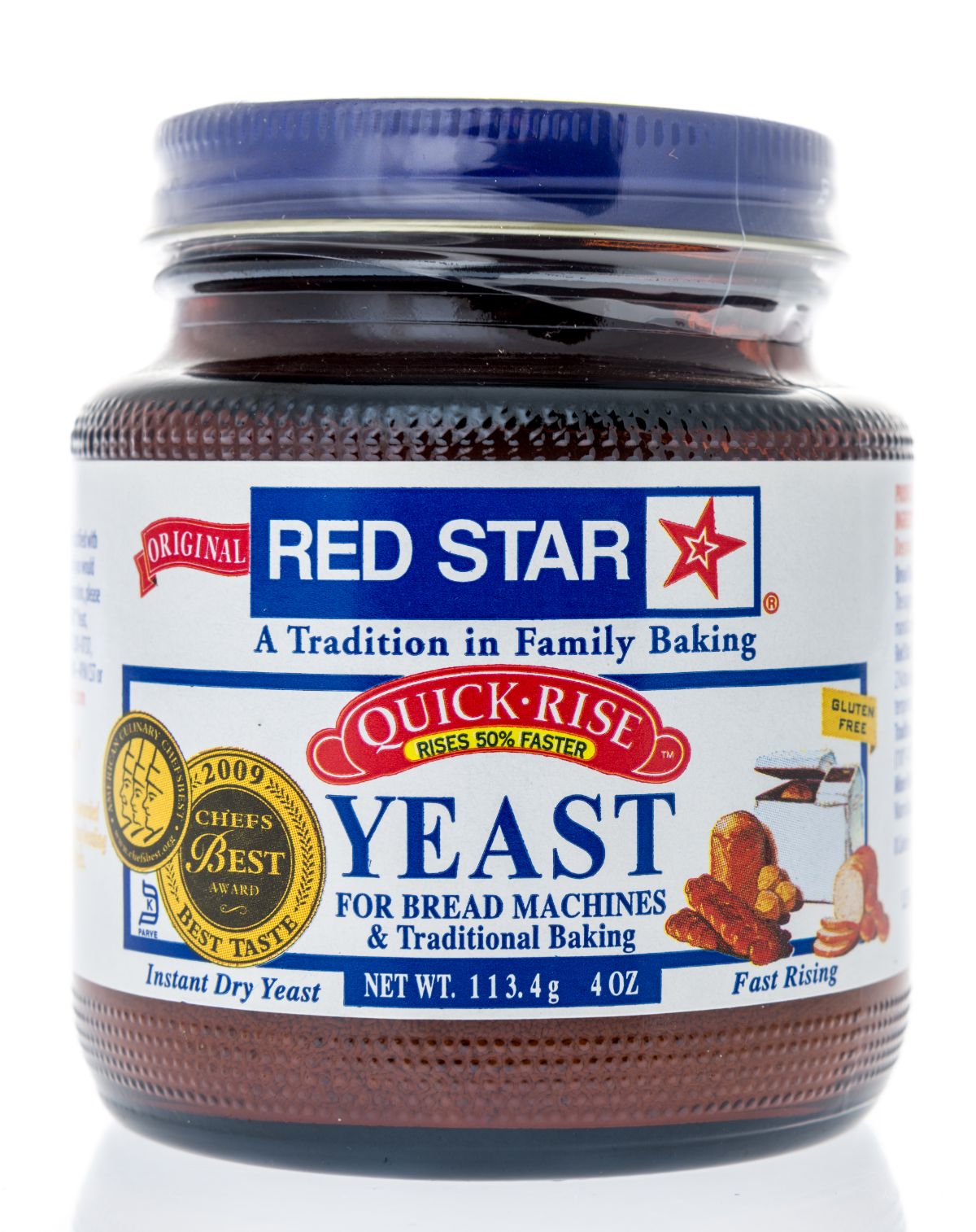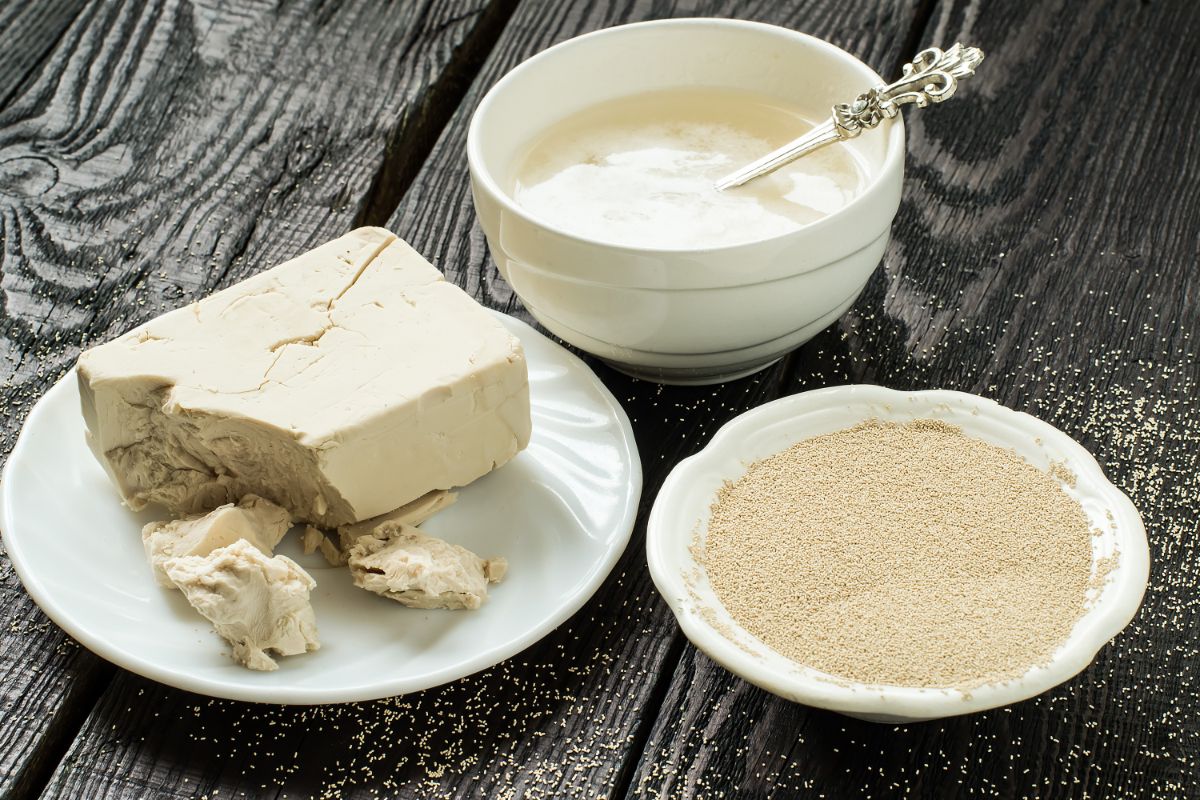Worldwide, there are only two types of yeast; regular yeast and bread machine yeast. The bread machine yeast is also called, fast-rising, quick-rise, rapid yeast, or instant yeast. You can easily use the two types of yeasts interchangeably.

So, what’s the difference between regular yeast and bread machine yeast? The main difference between these two types of yeast is their rising time. Otherwise, the size and texture of the granules is the main scope when choosing your most preferred type when shopping.
*This article may contain affiliate links. As an Amazon Associate, I earn from qualifying purchases. Please take that into account.
- Dutch oven
- Large mixing bowl
- Measuring cups and spoons
- Bread thermometer (fancy or a budget one)
- Scoring lame
Extra (nice to have):
- Kitchen scale
- Dough scraper and bowl scraper (yes, they are different)
- Cooling rack
- Baking stone (you don’t need a dutch oven if you use this)
👉Learn how to make bread and pizza with this awesome book.
Bread machine yeast
This type of yeast is specifically designed for the bread machine baking. It is available in different outlets in the world. Usually, the yeast is milled to form small granules with fine texture. It is for this reason that the yeast is easy to incorporate into the dry dough for instant baking.
Bread machine yeast has numerous cells than any other type of yeast. Just a few tbsp. of the yeast is enough for your recipe.
The cells in the bread machine yeast are always active. Once it is mixed with other ingredients, it triggers an instant rise. Unlike other types of yeasts, bread machine yeast undergoes only one rise and no proof. It is the most convenient type of yeast.
However, it is worth noting that the longer the period for rises, the fluffier, airier, and tastier the finished products. Instant rise yeast does not give the dough enough time to proof or rise. As a result, it bakes products with inferior taste as compared to the regular dough.
With no proof, one rise, and no kneading, baking with the bread machine yeast is the easiest and cleanest method in domestic baking. It is also ideal where there is a need to bake a large number of finished products in a fixed time frame.
Regular yeast

Regular yeast is the most commonly used in bread baking. It is popularly called the traditional yeast since unlike the bread machine one; it does not need to be milled to form fine granules. Its large granules have a coarse texture when felt between the fingers.
Just like the instant yeast, you can use this type of yeast in your bread machine. With the delayed mode, your dough will be guaranteed the longer time needed for preparation. Generally, this time is twice as long as the one for the rapid rise.
With regular yeast, the dough undergoes several rises. Depending on the period of rest, these can be three to four. Additionally, the dough will require another time for proofing before the final baking. With this down, the prep time using regular yeast is more than three times that of the rapid rise.
Regular yeast must be activated first before incorporation with other baking ingredients. The best way to go about this is through hydration with lukewarm water. The water should be at a temperature of about 37-43 degrees Celsius.
For regular bread leavening, this is usually the first step before doing anything. Lukewarm water provides an ideal temperature that when maintained realizes the optimal action of the yeast cells.
During the activation, it is advisable to add a pinch of sugar into the water. Sugars are the yeast’s main food. It, therefore, encourages the metabolism of the yeast cells. Alternatively, you can use the molasses in place of sugar. Once you have activated the yeast cells, you can proceed with other procedures in baking.
For an outstanding quality of the finished products, you can leave your dough to rest for 8-10 hours. This period is enough for all the rises and proves. Once you are done making the dough, you can either use the oven or bread machine for the final cooking part.
The main advantage of this type of yeast is that it has a longer shelf life. Unlike the bread machine yeast, you don’t need to refrigerate the yeast for a longer stay. It is for this reason that many home bakers prefer it over its counterpart.
Factors to consider when choosing between regular and bread machine yeast:
1. Convenience
Instant yeast has the added advantage of convenience. It bakes like a pro in no minute. Therefore, where time is a big deal, it is better to work with the instant yeast at the expense of the regular yeast.
All you need is to add the yeast in your bread machine alongside other ingredients and wait for about ten minutes to have your fully baked product. No proof, just mix and bake!
2. Finished products
Though the two types of yeasts work alternatively, the taste of the finished product matters a lot. Where airy and “yeasty” taste is a consideration, it is better to work with the regular yeast. However, some ingredients go bad faster. As a result, they make not work with the regular yeast even when the baker demands a tastier outcome.
3. Cost
Regular yeast is more economical to acquire than bread machine yeast. The processing process of the instant yeast is an added cost that reflects in its final price.
4. Shelf-life
Though it takes a long period before the yeast cells die in both cases, shelf-life is key more so where the baker lacks a refrigerator. By grinding the granules of the instant yeast, it is rendered highly perishable hence the need to keep it in the refrigerator.
Therefore, it cannot be a good option if you want something for long-term use. On the other hand, the larger granules in the regular yeast are covered with dead layers.
During activation, lukewarm water scraps off the layers to activate the yeast cells. It is for this reason that the yeast can stay over the counter for years without dying.
Conclusion
You can easily substitute instant rise yeast with regular yeast or vice versa in machine bread baking. However, when doing this, you will need to know how to balance the proportions in your recipe.
For 1 tbsp. of the bread machine yeast, use 1 ¼ tbsp. of the regular yeast. And, for 1 tbsp. of regular yeast, use ¾ tbsp. of bread machine yeast. Just stick to the ¼ margin.
